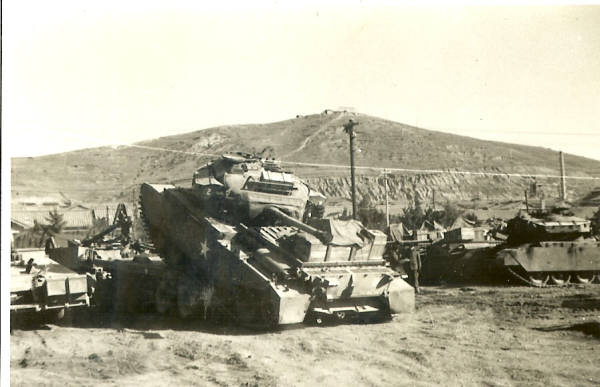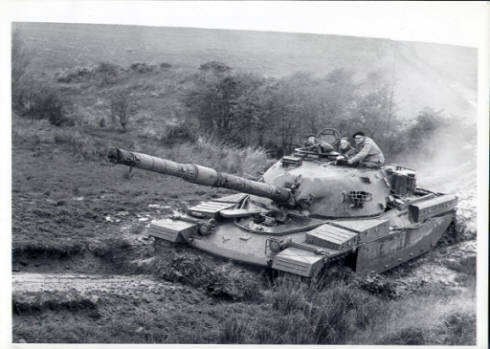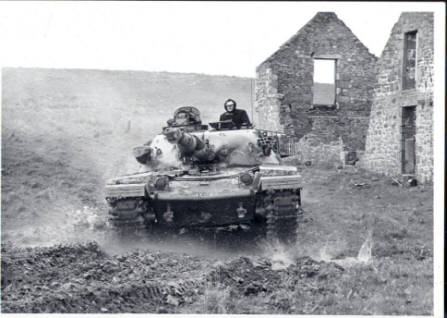
Elephantine and Explosive Manoeuvres
Have you not yet guessed what they were? Well they were all tanks used by the British Army. Several other national forces like Israel and Iran also bought them especially the Centurion.
I have never discovered why the Army gave them names beginning with "C". My wild guess is that they were linked somehow with the idea of mobile castles but that is really a bit farfetched. More likely it was just a practice that became a tradition. But there are exceptions to every rule as I know of at least two British tanks named differently. These were the Tortoise and the Valentine. The former being well named because it was so slow and ponderous. The Valentine may have been named that way because it was light fast and with a gun so small that being hit by one of its missiles was perhaps akin to a kiss rather than anything more vicious. So perhaps the Army used the "C" to denote a successful design but I just speculate there.
I was brought up on the Centurion. This required a crew of 4 - Driver, Gunner, Loader and Commander. The driver sat behind the 6 inch front armour plate of the hull whilst the other three roosted above him in the turret. The turret, itself a heavily armoured piece of iron and steel carried a machine gun as well as the main gun and could be rotated through a complete circle even while the tank was moving over the ground.
I won't bore you with too many technicalities except to give you an idea of what was involved. The Meteor engine in the rear of the hull produced nearly 700 hp and was a development of the Merlin engine used in the Spitfires of Battle of Britain fame. The gear box was a very complicated affair that was placed right at the back of the tank driving the track sprockets. It was larger than a motorcycle sidecar.
The driver had a steering lever on each side of his tiny compartment. Between his legs there was an enormous gear lever, with a clutch pedal for his left foot and brake and throttle pedals for his right. When the tank was closed down for action the driver lowered his seat to close the hatch above him and steered by looking through a periscope set in the hatch. This was rather like peering through very dirty spectacles with over sized blinkers on either side of your eyes. In such circumstances one is somewhat disinclined to steer other than straight ahead which I suppose is what you are expected to do anyway when you are attacking or retreating!
I graduated to the Chieftain when it was being first produced as a prototype in the 60's I was posted to the Royal Ordnance factory in Leeds Yorkshire as SIO/E. I discovered soon after that the acronym meant Senior Inspecting Officer/Erection. Needless to say I was more than somewhat diffident about using the title in full and avoided trying to explain it to the uninitiated!
The Chieftain was a huge advance on the Centurion. It was designed to survive and fight in nuclear war. It was air conditioned, could snorkel to depths of water more than 6 feet above the turret. The main gun could be kept automatically on target whist the tank was on the move. Under these conditions the driver had to be aware of the movements of the turret above being independent of the way he was driving the hull itself. This could be especially hazardous in areas of close confinement like streets
The driver had the usual two steering levers, footbrake and throttle pedals. But the gear change was a simple motorcycle style lever operated by the left foot with no clutch as the gear box was entirely automatic. Even in the closed up position where the driver was required to lie on his back and peer through an improved periscope, driving was much easier in the Chieftain than in the old Centurion.
One of my more exciting duties at the ROF was to be part of a crew directed to test a production Chieftain to its limits. This involved transporting the tank on the back of a specially designed transporter to the MOD range in Scotland. After testing it we'd take it back to Leeds and report all the faults and weaknesses we had been able to discover.
With virtually a carte blanche and an unfettered opportunity to test every feature of the tank we had a ball!. The tests sometimes included live firing of the armament over the range in to the sea. This gave us the added excitement of destroying targets if we could hit them.
The sense of freedom and power on those occasions when I acted as driver were an extraordinary experience. The 800+ HP diesel engine could drive the tank over rough ground at up to 30 mph. At times it seemed that nothing could stop the 60 tonne monster when I got it going.
The testing range was mainly open hilly countryside, with one sealed access road and a number of dirt tracks. The fields were still demarcated by stone walls and the scattered remains of old fashioned stone buildings of abandoned farms and one small village. All showed the destructive effects of enthusiastic tank testers let loose to do their worst. Everywhere walls and buildings showed great gaps where tanks had passed through.
Naturally I was determined to make my own mark. Mind you this was all in a good cause as we were tasked to test the tank and this was a range provided for just that purpose! But I still have to wonder at my behaviour...in any other circumstances I would be justifiably described as a vandal. I had not realized before the depths of my desire to indulge in unrestricted exercise of destructive power.....
And so on a sunny morning three of us mounted the tank for a session of field testing. That was to include cross country driving with the main armament laid on a target to test the complete system. We were not to fire the gun, but certainly we were expected to do everything else to simulate a battle field run.

I was really enjoying myself in the driver's seat and I was fortunate (so I thought) in being told to "Have a Go". So I got the tank going across some rough ground and aimed for a distant track past some old buildings on the horizon. The turret crew were doing their own thing having laid the gun on a distant target to the right of the tank. Because there were only three of us the commander was doubling as gunner and being buried inside the turret he became oblivious to where the tank was heading.
Meanwhile, I was concentrating on driving the tank. In my excited state of unbridled power I became totally unaware of what the turret was doing. As we approached the building the turret had obeyed the commands of its automated target acquisition equipment and kept the gun laid on the distant target to the right of the tank. The angle between the hull and the gun gradually increased. By the time we arrived at the building the barrel of the gun was sticking out a fair distance to the side and the inevitable happened. The gun hit the building before the tracks reached it. Fortunately it was only a glancing blow. Nevertheless the turret crew was somewhat shaken as we continued our remorseless way over the remains of a stone wall and onto the muddy track beyond.
Apart from scratches on the gun barrel the tank seemed OK so we continued. But not before the tank commander and I had a somewhat heated discussion over responsibilities......


Thankfully nothing further happened. The factory authorities appeared to have accepted the damage as one of the consequences of the enthusiastic testing they had commissioned us to do.
In this instance the motto of the RTR:
"Through Mud and Blood to the Green Fields Beyond", could more appropriately have been:
"Over open fields through stone walls to the bent gun beyond"